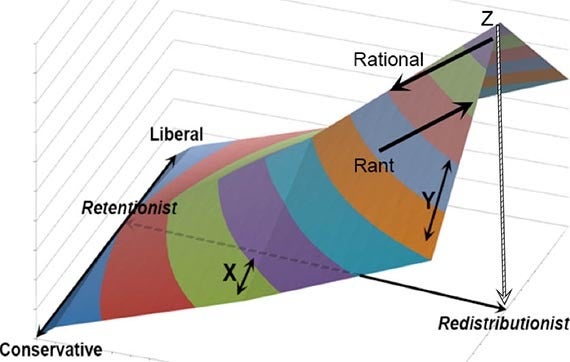How has the Republican Party picked its nominees for president in the past two elections? And why was this year different? Why did the Democrats pick the candidate they did, and why didn’t she have a chance with her campaign strategy? Why won’t the Republicans nominate another Donald Trump? And what do the Democrats have to do differently to win in 2020?
In the recent past the Republican primaries and the Republican National Convention went for the most ideologically pure candidates. Their primaries selected rightest of the right. Those candidates fared best in the primaries but were unelectable in the general election. Let’s see why.
Voting in the primaries is “expensive.” There is little social pressure to turn out. There are few other decisions of interest. Referendums and Plebiscites are decided in the fall. And voting in the caucuses and town hall meetings can take hours. Most of us wait until the general elections before we get actively involved. But the most passionate among us are willing to pay the high price of voting in the primaries. This seems a lot like marketing great craft beer. Most of us are happy enough with a Bud or a Heineken. Only the most passionate pay the high price of drinking a Lost Abbey Devotion or an Allagash Curieux.
However, the general elections are much less expensive than the primaries. They are faster than caucuses and town hall meetings. There is social pressure to turn out. As a result, the winner in the general elections has been the candidate who is more traditional and more marketable to the larger population, not the candidate who is more marketable to the passionate few who vote in primaries. Paradoxically, since Democrats have been less passionate and less certain, they have selected candidates who were more acceptable to the middle of the political spectrum. Republican candidates were pure and firmly grounded in the right wing of their party. If they were not, like Senator John McCain, they found themselves “whack job” running mates. Democratic candidates were not ideologically pure. But they were electable.
But this year was different. Historically, passionate voters have been distributed on the left-to-right ideological axis, with the greatest passion at the left right extremes, where there were the fewest voters. This year we also had an up-down axis, an axis of those who were comfortable with their social and economic positions and those who were not. The contented few were the truly wealthy, who wanted to maintain the privileged positions, the most extreme of the Retentionists. Joining them were the masses of college educated successful middle classes, the lawyers, the college professors, the doctors, and of course the consultants.
At the other extreme were the Redistributionists, those who felt that the current order had failed them or was about to fail them. The young went for Senator Bernie Sanders, who promised them jobs and justice. The older and angry formed the base of Donald Trump’s campaign, because Trump promised them jobs and some degree of retribution. And there were a lot of angry Trump voters. Unlike the passionate few on the left and right axis of political choice, the passionate many resided on the extreme end of the Redistributionist axis. Secretary Clinton almost lost the primaries because she underestimated the number of passionate Redistributionists on the left side of the political spectrum. She didn’t have a prayer in the general election because she could never appeal to the passionate Redistributionists of either side of the left-right political spectrum.
Let’s see why. The angrier Mr. Trump looked, the less experienced he looked, even the more outside political norms and the less competent he looked to the main-stream voter, the better he looked to the passionate Redistributionists. The more he was shown ranting on TV, the more Redistributionist voters he attracted. In contrast, the more experienced, the more inside political norms, and the more competent Secretary Clinton looked, the fewer Redistributionist voters she was able to attract. Her campaign was all wrong for the new electoral reality. With the Electoral College structured the way it is, and her contented voters heavy clustered in a few states, she didn’t have a chance competing against Mr. Trump’s masses of Redistributionists.
Secretary Clinton couldn’t win by arguing that Trump was unqualified. As importantly, he couldn’t lose by doing things that made it appear he was disqualifying himself. The only way she could have won would have been by competing on ideas going forward and by convincing the alienated Redistributionists that she had better programs for them. That’s hard to do with sound bites. That’s hard to do even in the best of times, the calmest of times. And these were not those times.
What should we expect now that Mr. Trump has been elected? Mr. Trump was smart enough to get elected and I suspect that he is smart enough to govern. Now he needs to get things done inside Washington, not merely to prove he is an outsider. He made no promises to special interests to get elected, so he doesn’t owe anything to anyone. I suspect that he will be a pragmatist on health care; indeed, the early signs confirm this. I suspect that he will be a pragmatist on gun control and women’s health issues. I suspect he and his economic advisors know that no matter what they do to bring manufacturing back to the Midwest they will not be able to bring manufacturing jobs back, and they will be pragmatic about training and retraining. Still, I don’t want to appear too naïvely optimistic. His team of advisors looks more like the team running a small family business than the team running the most powerful country on earth, which does not fill me with confidence. His environmental policy may doom our children. I do wish Hillary had run a better campaign.
Why won’t the Republicans nominate another Donald Trump? Because, quite frankly, he promised things that could not be delivered. Mr. Trump won because voters were convinced that anyone from outside Washington was a better bet than anyone with experience, and because he promised his voters a return to what they believed was a better world. When he does an even worse job than his predecessors on both sides of the aisle we can go back to running experienced professionals.
And what should Secretary Clinton have done differently? Her campaign should not have attacked Mr. Trump for being unsuited for the job, because his supporters thought that was his strength! She should have attempted to demonstrate the value of her policies. It’s not clear that would have worked this year. It’s not clear any of his supporters could have been persuaded by policy details.
My first discussions with Arianna Huffington dealt with the future of American Democracy in 2009. She was certain that Obama’s victory proved that the net represented a triumphant return to the Athenian Agora, to the Golden Age of Pericles, and to participatory democracy. I was afraid that the net represented a return to demagogues and appeal to mob rule, which ended the Golden Age in less than 25 years. I think the verdict of history is still unclear.
Any math wonks reading this can look at the following figure. The rest of us can skip it. Note that the farther forward a position is on the graph, the more conservative the position is; the deeper back into the page a position is, the more liberal it is. The farther to the left a position is, the more comfortable and Retentionist it is, and the farther right a position is the more alienated, dissatisfied, angry, and Redistributionist it is. As importantly, the higher up on the page a position is the more people that position represents. Thus, there are more people who are politically central than extremely left or right, and there are more people who are extremely dissatisfied than the number of people anywhere else in the graph.
The traditional Republican candidates, like senators Rubio and Cruz, or governors Bush and Kasich, didn’t have a chance in the primaries. They were dueling for the same small pool of voters shown along the line marked X. In contrast, Mr. Trump was staking sole claim to the voters along the line Y. There were more of them. And they were all his. Of course he won the primaries. He won with a walk-off home run.
In the general election, Secretary Clinton tried to claim the voters near the point Z. These were the most numerous voters, moderately centrist and extremely Redistributionist, there were so many of them. She wanted both the Centrist mantle of Governor Kaine and the populist Redistribution supporters who had backed Senator Sanders. However, she could never establish her populist Redistributionist credentials. The more she attacked Mr. Trump, and the more over the top he appeared, the stronger his claim on voters along Y became. The more competent she looked, and the more she looked like a member of the government, the weaker her claim on voters at Z became. Again, the way she ran her campaign and the way he ran his, she didn’t have a chance. He couldn’t lose by ranting. She couldn’t win by appearing rational.

